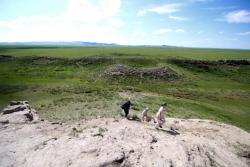Visual Cultures of Mongolia
August 8 - 20 2016
The Visual Cultures of Mongolia program is a 13-day exploration of Mongolia’s past and present seen in crumbling ruins, the rolling steppe, white-washed temples, nomadic homes, forested backcountry, modern museums, and ancient ritual sites.
The program is structured around four primary themes:
Landscapes

Spiritual Life of Mongolia

Material Culture of Mongolia’s Past

The Ruins of Empires Program

Participants will develop photographic and anthropological perspectives on the history, culture, religions, and artistic traditions of Mongolia from the deep past to the 21st century.
You will visit and explore a variety of famous sites, live in Mongolian ger--traditional nomadic dwelling--and adventure on horseback, camelback, and foot in search of new vistas, forgotten finds, and remote places.
The Center for the Study of Eurasian Nomads invites applications from adults of all ages and backgrounds who wish to expand their horizons through interactive learning in the field this summer.
For total program information please consult the Visual Cultures of Mongolia Handbook.
To apply, please complete and submit the Application.
Visual Cultures of Mongolia - 2016 CSEN Field Program
Location: Mongolia
Season:
August 8, 2016 to August 20, 2016
Application Deadline:
Sunday, May 1, 2016
Deadline Type:
Exact date
Program Type
Volunteer
no
Affiliation:
Center for the Study of Eurasian Nomads (CSEN)
Project Director:
Robert (Bob) Haft, The Evergreen State College
Project Description
The “Visual Cultures of Mongolia” program will take a photographer’s eye and an anthropologist’s approach to architecture, fine arts, religious and spiritual iconography, public and private visual landscapes, and the many juxtapositions in Mongolian imagery (sacred vs. profane, natural vs. built, foreign vs. indigenous) from deep prehistory to the 21st-century. Our Program Director will lead participants in creating a photographic account and daily reaction journal of our team’s engagements with monuments, monasteries, and modern herders in order to cultivate a visual understanding of the complexities of Mongolian society and history. Over the course of 13 days in Ulaanbaatar and the Mongolian countryside, the program explores four primary themes:
- Landscapes
- Spiritual Life of Mongolia
- Material Culture of Mongolia’s Past
- The Ruins of Empires
Period(s) of Occupation: Paleolithic through early modern sites in Central Mongolia, including Khar Balgas/Ordu Balik (Arkhangai Province), Khar Bukhyn Balgas and Sumyn Am (Bulgan Province), Rashaan Khad and Uglugchiin Kherem (Khentii Province), and Qara Qorum (Uvurkhangai Province).
Notes:
Each day the senior staff will lead our team through a variety of key sites of cultural, religious, and/or historical significance through a combination of lecture walks, hands-on activities, and critical engagement (photography, sketching, and journaling). Key sites are noted in the Program Map found in the Handbook. We will structure our exploration of program sites and other activities around the four primary program themes: Landscapes; Spiritual Life of Mongolia; Material Culture of Mongolia’s Past; and The Ruins of Empire. The following schedule lists the main events, activities, and locations for the program. These plans are subject to change at the discretion of the senior staff.
Project size:
1-24 participants
Minimum Length of Stay for Volunteers: Full program length: August 8-20, 2016
Minimum age:
18; no upper age limit
Experience required:
No prior experience required. Background in the following preferred but not required: photography, archaeology, religious studies, field research, anthropology, and/or history.
Room and Board Arrangements
Please see the attached Visual Cultures handbook for a full description of program room and board.
Cost:
Participant tax-deductible contribution: $3,870. Please consult the program handbook for a complete description of what is and what is not covered by the participant contribution.
Academic Credit
Number of credits offered None
Tuition:
Participant tax-deductible contribution: $3,870
LOCATION
Recommended Bibliography:
Christopher Atwood's "Encyclopedia of Mongolia and the Mongol Empire" (2004)
B. Baabar's "History of Mongolia" (1999)
Charles Bawden's "The Modern History of Mongolia" (1968)
Manduhai Buyandelger's "Tragic Spirits: Shamanism, Memory, and Gender in Contemporary Mongolia" (2013)
Nicola Di Cosmo's "Ancient China and its Enemies" (1999)
Natasha Fijn's "Living with Herds: Human-Animal Coexistence in Mongolia" (2011)
William Honeychurch's "Inner Asia and the Spatial Politics of Empire: Archaeology, Mobility, and Culture" (2015)
Esther Jacobson-Tepfer's "The Hunter, the Stag, and the Mother of Animals: Image, Monument, and Landscape in Ancient North Asia" (2015)
Chris Kaplonski's "The Lama Question: Violence, Sovereignty, and Exception in Early Socialist Mongolia" (2014)
The Deer Stone Project: Anthropological Studies in Mongolia 2002-2004. Edited by William W. Fitzhugh, J. Bayarsaikhan, and Peter K. Marsh (2005)
"The Secret History of the Mongols" (Igor de Rachewiltz translation if available)
"The Travels of Marco Polo"





No comments:
Post a Comment